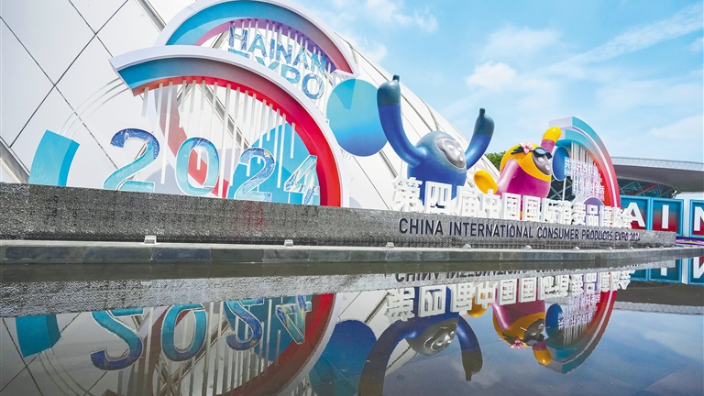By continuing to browser our site and use the services you agree to our use of cookies, Privacy Policy and Terms of Use. You can change your cookie settings through your browser.
As China’s most treasured holiday, Chinese New Year, also known as Spring Festival, is all about celebrating family gatherings and expressing hopes for new possibilities. It is a time people most look forward to and yet also the busiest time of the year. Interested in how Spring Festival is celebrated by locals in Haikou? You’ll find all kinds of fascinating traditions described below. Why not try some of them yourself?
Before Chinese New Year’s Eve
Shopping for Necessities
Some locals may begin to prepare for the festival as early as just after Mid-Autumn Festival. When it comes to shopping for necessities, although online shopping is very popular now, many people would recommend going to Bo’ai South Road for the full CNY experience. This is where you can find everything you need for the festival. Spring Festival couplets, red envelopes, orange trees, red lanterns, electronic firecrackers, Chinese knots, candy, and other snacks are all available here. It’s the perfect place for convenient, one-stop shopping!

(en.explorehainan.com)
Cleaning the house
After shopping, pick an auspicious day and do a thorough cleanup of your house. Sweeping up dust is usually done with a new broom made from green bamboo branches and leaves. Spring cleaning is an important ritual, as it represents a wish to sweep away bad luck and bring in good fortune. In some areas, people also burn old, worn-out clothes outside their houses, to get rid of poverty.
Putting up Decorations
On Chinese New Year’s Eve, or a day before it, new couplets are posted on doors, where they normally remain until they are replaced the next New Year. Haikou locals may also put up a red paper (called Li Shi Paper in mandarin) below the crosspiece of the couplets, and hang up a red string with tangerines attached (“tangerine” sounds similar to the word “wealth” in mandarin), wishing for happiness and prosperity in the coming year. Additionally, houses are also decorated with red lanterns, paper cutouts, and New Year’s paintings.


(Li Jiafei)
On Chinese New Year’s Eve
Worshipping Ancestors
Worshipping ancestors is considered the top priority on New Year’s Eve for local people in Haikou, and must be done before the reunion dinner, to show that they are letting their ancestors “eat” first. Boiled chicken & fish, steamed sponge cake, tangerines, and other sacrifices are placed in front of the ancestors’ memorial tablet. Usually descendants first burn paper money, present candles and sacrificial offerings, and then salute their ancestors.

(en.explorehainan.com)
Hotpot for the Reunion Dinner
After worshipping the ancestors, the New Year’s Eve Feast is a “must-have” dinner with all family members eating together. In Haikou, the New Year’s Eve dinner is called the “stove dinner” by local people, as family members sit around a stove with a pot on it. Chicken, mutton, and green vegetables are served as mainstay dishes, and typical local dipping sauce ingredients include a mixture of sauces, yellow lantern peppers, garlic paste, as well as calamansi juice, which adds a final touch to the mouthwatering feast!

(en.explorehainan.com)
After the dinner comes the highlight of the evening for the children, who receive red envelopes filled with crisp banknotes (lucky money) from their elders and may stay up all night.
Eating a Vegetable Stew
In contrast to the big feast on New Year’s Eve, people in Haikou have a vegetable stew for their first meal on New Year’s Day. You might notice that vegetable prices get a bit higher around the New Year, and this is why! A big pot of vegetable stew is made with all kinds of fresh vegetables, including lettuce, celery, eggplant, wood ear, mung bean noodles, and more, all carrying different new year wishes. Why not start the new year with a healthy vegetable stew?

(en.explorehainan.com)
In addition to not eating meat (because killing animals and using knives on the first day of the new year are considered unlucky), there are many other taboos for this day, such as no breaking dishes, no washing clothes, no needlework, no lending or borrowing money, and more. One of the most important of these is not to sweep the floor, since the act is associated with sweeping wealth away.
Watching a Chinese Dragon Dance
After breakfast, local people usually go out for some fresh air and take a stroll with their family members, perhaps in Evergreen Park, the largest open tropical seashore park in the city. Shopping malls and supermarkets, in contrast, appear cold, empty, and cheerless on this day.
In some towns and villages such as Dongshan Town in Xiuying District, traditional folk performers are invited to perform a Chinese Dragon Dance on the streets, carrying new year wishes from door to door. The dance team is welcomed everywhere it goes, and are sometimes given red envelopes with cash inside by the local people.

(en.explorehainan.com)
After the Chinese New Year Day
Visiting Relatives & Friends
Traditionally, married daughters visit their parents’ home with their family members on the second day of Chinese New Year. From the third to the seventh day of the New Year, people visit relatives and friends, wishing each other “happiness and prosperity” or “Happy New Year”. It is also customary for the younger generation to visit their elders, wishing them health and longevity in the coming year.
16 New Measures Set to Make Life in Hainan for Foreigners Easier
08:10, 18-April-20244th CICPE Helps Hainan’s Yacht Industry Development
03:37, 18-April-2024New friends, new opportunities at the Hainan Expo
03:37, 18-April-2024Fáilte go Hainan! FTP Becomes Top Destination for Irish Firms
03:37, 18-April-2024Michael's EV Journey in Haikou
03:37, 18-April-2024OCOs on Expo: Inira’s magical Hainan Expo journey
06:01, 17-April-2024By continuing to browser our site and use the services you agree to our use of cookies, Privacy Policy and Terms of Use. You can change your cookie settings through your browser.





